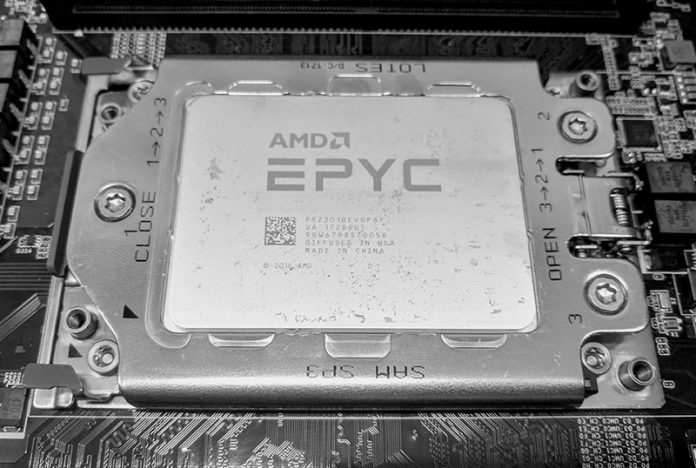Today we have our Linux benchmarks and review of the AMD EPYC 7301 CPU in a single-socket configuration. The AMD EPYC 7301 is a dual socket capable part which is we see the most common deployment scenarios for the chip. In practice, we expect the most common single socket EPYC 7301 deployment scenario will be in dual socket capable servers that eye the potential of adding a second CPU later in the lifecycle. Otherwise, the AMD EPYC 7351P makes a more compelling single socket server chip which is part of AMD’s product and pricing strategy.
At STH, this is now our fifth single socket AMD EPYC review along with three dual-socket pieces. We have tested a full range along with a full range of Intel Xeon Bronze and Silver offerings as well as many in the Gold and Platinum line. Suffice to say, we are extremely impressed with the AMD EPYC 7000 series thus far and the results herein will show you why.
Key stats for the AMD EPYC 7301: 16 cores / 32 threads, 2.2GHz base and 2.7GHz turbo with a whopping 64MB L3 cache. The CPU features a 155-170W TDP. Here is the AMD product page with the feature set. Here is the lscpu output for the processor:
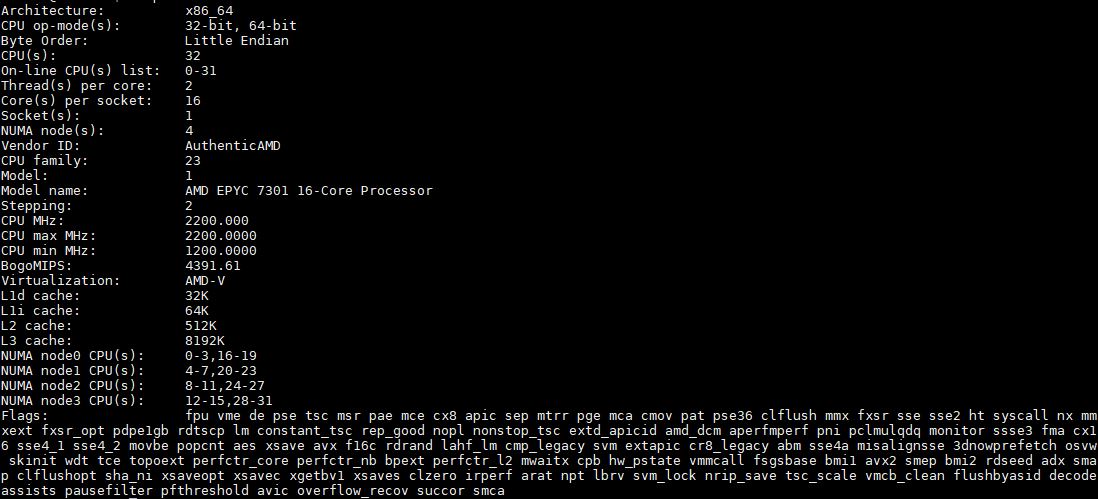
The key here is that the single socket AMD EPYC 7301 uses a four NUMA node implementation. You can read more about why in our AMD EPYC 7000 Series Architecture Overview for Non-CE or EE Majors article or learn about it in this video:
Test Configuration
By the end of September, had every AMD EPYC SKU tested on a common Tyan EPYC platform and work started on another platform. Here is the base hardware configuration we are using:
- CPU: AMD EPYC 7351P
- Server Barebones: Tyan Transport SX TN70A-B8026 (B8026T70AE24HR)
- RAM: 8x 16GB 128GB DDR4-2666 RDIMMs (Samsung)
- SSD: 1x Intel DC S3710 400GB SATA SSD
- NIC: 1x Mellanox ConnectX-3 Pro EN VPI
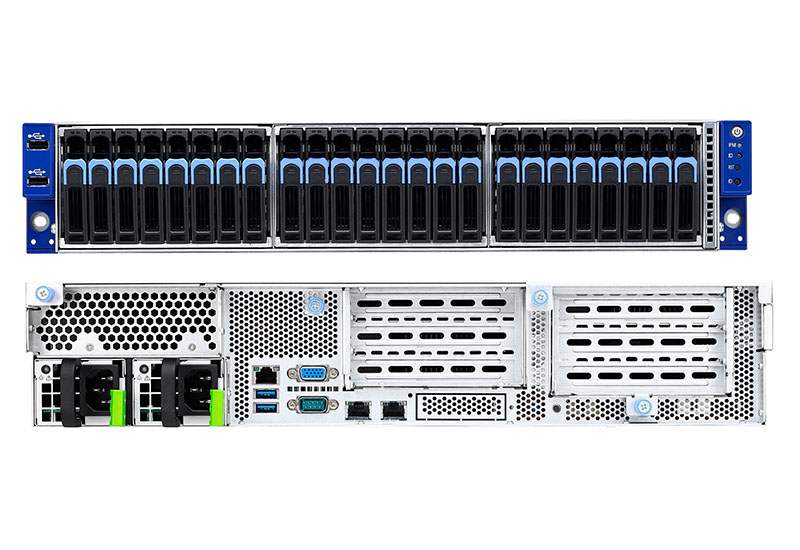
Key to this system is that it supports 24x NVMe U.2 NVMe SSDs without using Broadcom PLX PCIe expanders. That is 96 lanes of PCIe 3.0 directly from a single SKU. One of the key advantages AMD EPYC has is that a single EPYC CPU can use 128x PCIe lanes, the same number as the dual socket configuration. Tyan has responded to this opportunity by offering a single-socket system that can handle 24x NVMe drives plus have I/O available for 10/25/40/50/100GbE.
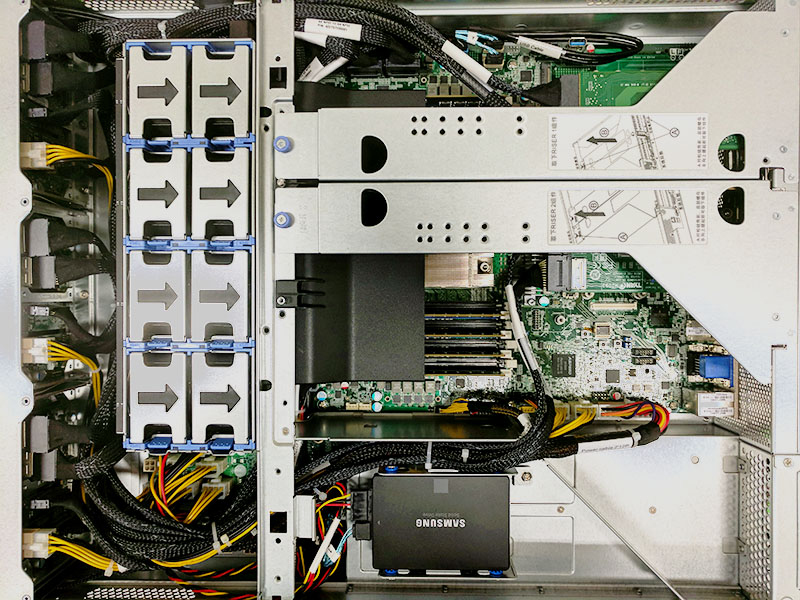
AMD and Tyan originally suggested that we use a Samsung SSD (as pictured), however, to aid in consistency, we are using our lab standard Intel DC S3710 400GB SSDs.
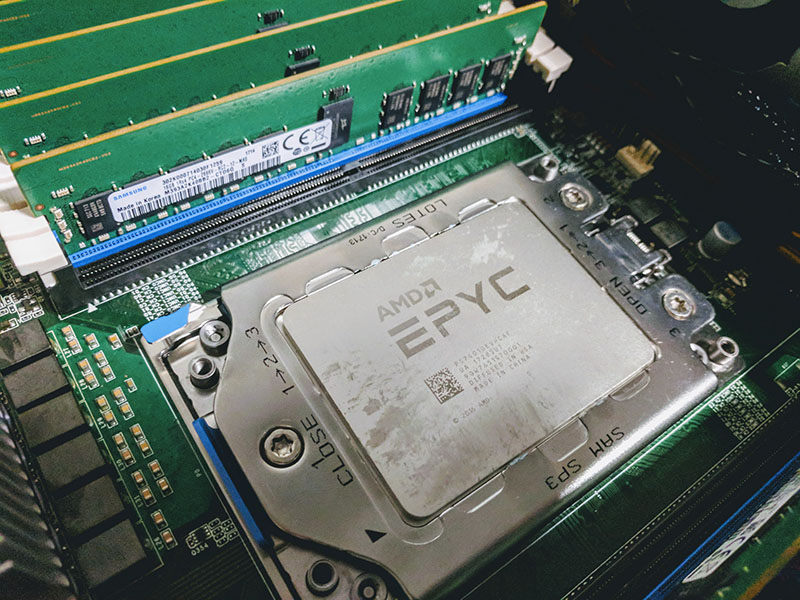
In our forthcoming system review, we will have data on every CPU from the AMD EPYC 7251 to the EPYC 7601 for those looking at the system.
AMD EPYC 7301 Benchmarks
For this exercise, we are using our legacy Linux-Bench scripts which help us see cross-platform “least common denominator” results we have been using for years as well as several results from our updated Linux-Bench2 scripts. At this point, our benchmarking sessions take days to run and we are generating well over a thousand data points. We are also running workloads for software companies that want to see how their software works on the latest hardware. As a result, this is a small sample of the data we are collecting and can share publicly. Our position is always that we are happy to provide some free data but we also have services to let companies run their own workloads in our lab, such as with our DemoEval service. What we do provide is an extremely controlled environment where we know every step is exactly the same and each run is done in a real-world data center, not a test bench.
Python Linux 4.4.2 Kernel Compile Benchmark
This is one of the most requested benchmarks for STH over the past few years. The task was simple, we have a standard configuration file, the Linux 4.4.2 kernel from kernel.org, and make the standard auto-generated configuration utilizing every thread in the system. We are expressing results in terms of compiles per hour to make the results easier to read.
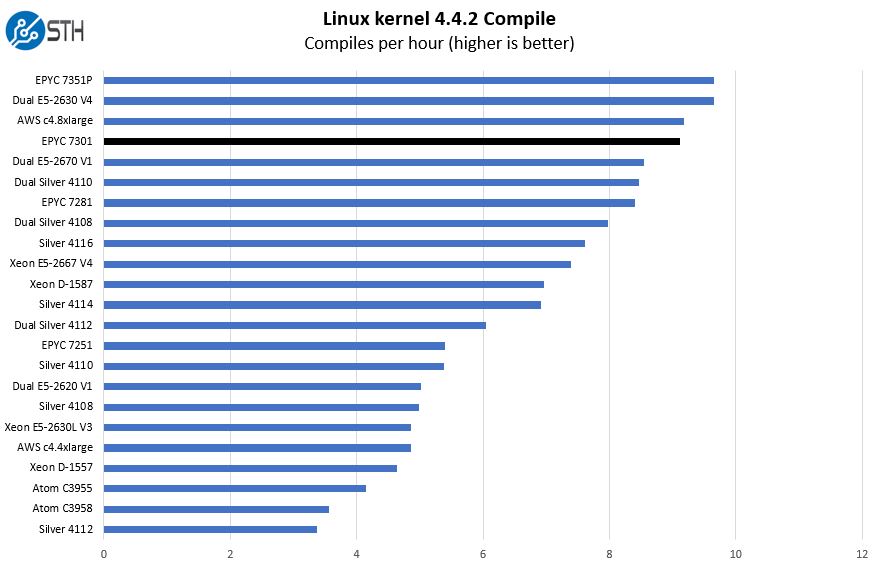
As we would expect, solid performance. We did want to, at the outset of this review, point to the AMD EPYC 7351P. It is one of three single-socket specific SKUs AMD released with this generation. It is about 10% less expensive than the 7301, and has higher clocks. On the flip side, it can only be used in single-socket configurations. As we suggested in our Single Socket AMD EPYC 7000 FAQ Answers to Common Questions if you are using a single socket EPYC platform, the single socket “P” parts are our preferred option. This chart is a good illustration of why that is the case.
c-ray 1.1 Performance
We have been using c-ray for our performance testing for years now. It is a ray tracing benchmark that is extremely popular to show differences in processors under multi-threaded workloads. We are going to use our new Linux-Bench2 8K render since it teases out more differences in this CPU segment than our older 4K results.
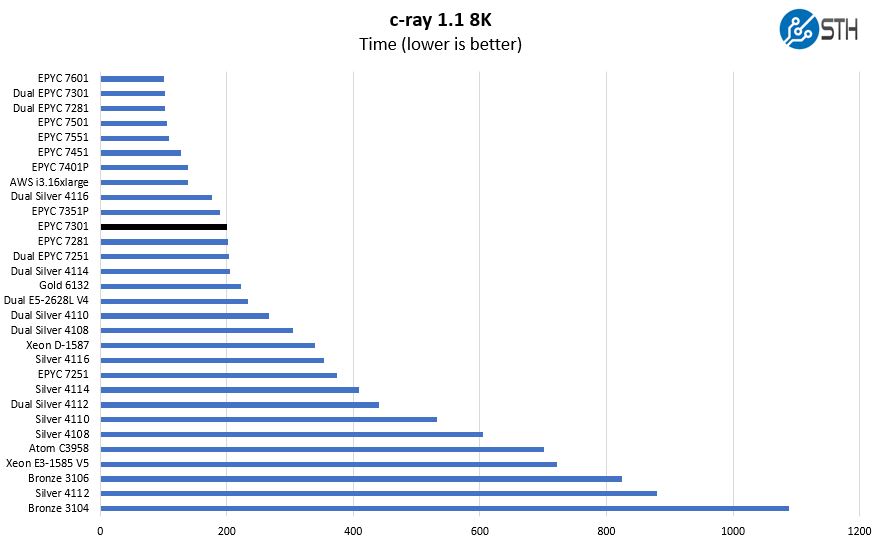
AMD typically does well in this type of workload so you can see that the performance is exceptional here. Having 16 cores propels the chip past a more expensive Intel Xeon Silver 4116 with only 12 cores.
7-zip Compression Performance
7-zip is a widely used compression/ decompression program that works cross-platform. We started using the program during our early days with Windows testing. It is now part of Linux-Bench.
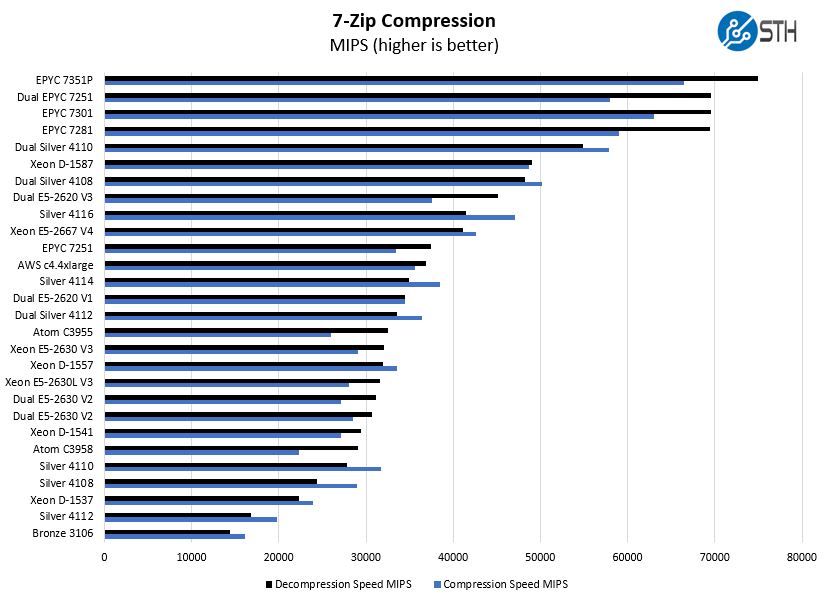
Here we can see extremely competitive results and another case supporting the idea that the AMD EPYC 7301 is a significant upgrade over the AMD EPYC 7281.
NAMD Performance
NAMD is a molecular modeling benchmark developed by the Theoretical and Computational Biophysics Group in the Beckman Institute for Advanced Science and Technology at the University of Illinois at Urbana-Champaign. More information on the benchmark can be found here. We are going to augment this with GROMACS in the next-generation Linux-Bench in the near future. With GROMACS we have been working hard to support Intel’s Skylake AVX-512 and AVX2 supporting AMD Zen architecture. Here are the comparison results for the legacy data set:
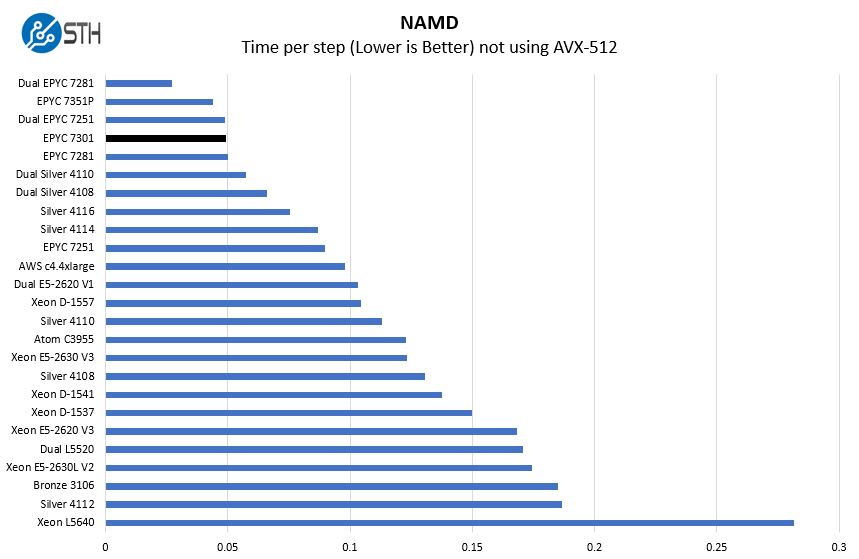
This is an interesting case where having twice the cores and cache make the $825 AMD EPYC 7301 about twice as fast as dual AMD EPYC 7251 ($475 each).
Sysbench CPU test
Sysbench is another one of those widely used Linux benchmarks. We specifically are using the CPU test, not the OLTP test that we use for some storage testing.
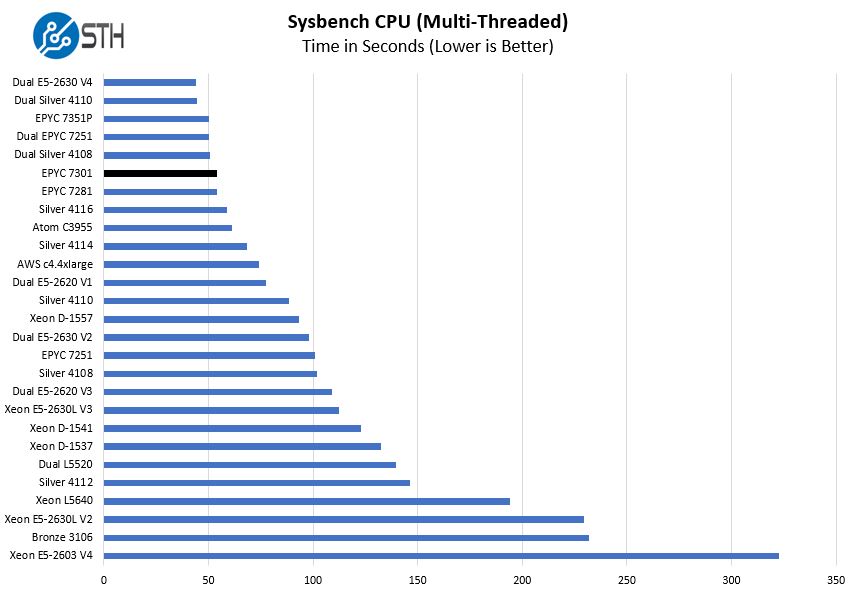
This is another example where the AMD EPYC 7301 outperforms every Intel Xeon Silver CPU.
OpenSSL Performance
OpenSSL is widely used to secure communications between servers. This is an important protocol in many server stacks. We first look at our sign tests:
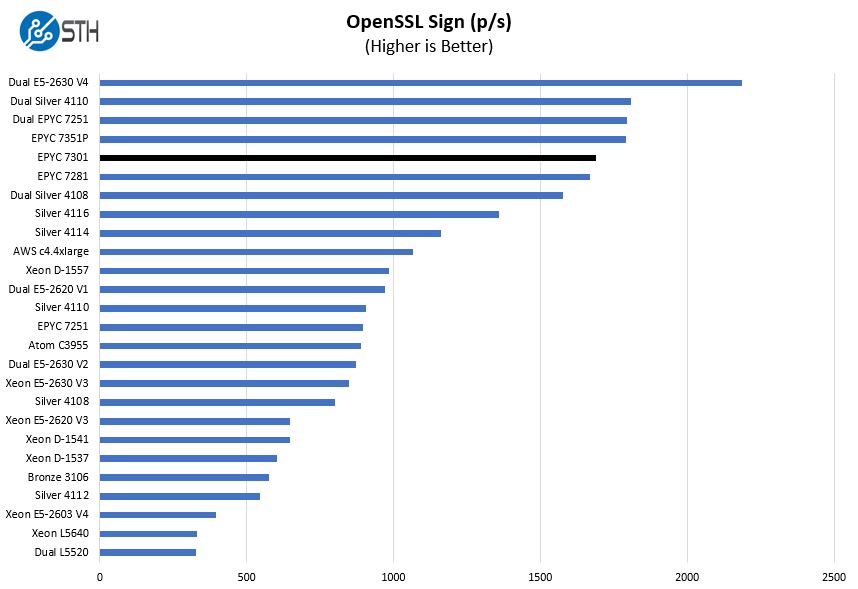
And the verify results:
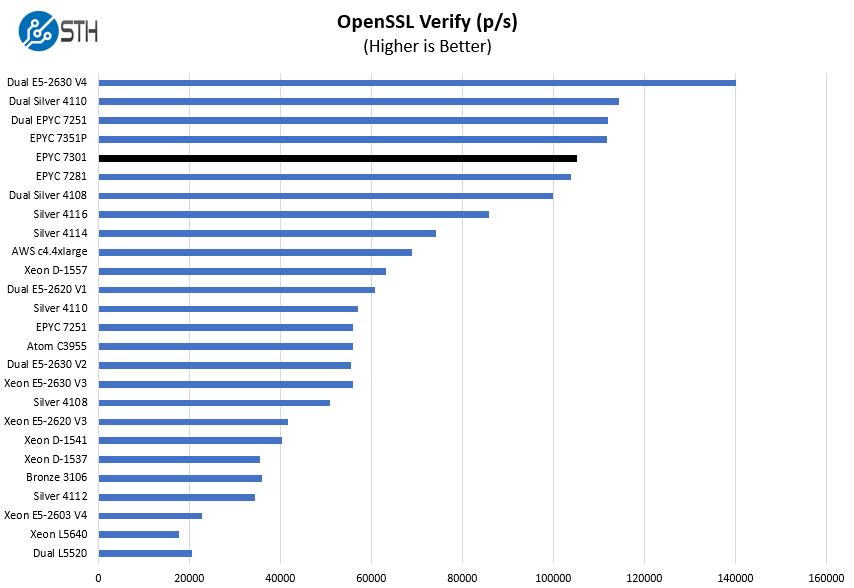
Here we see some awesome figures for the AMD EPYC 7301 part besting a dual socket Intel Xeon Silver 4108 setup.
UnixBench Dhrystone 2 and Whetstone Benchmarks
Some of the longest-running tests at STH are the venerable UnixBench 5.1.3 Dhrystone 2 and Whetstone results. They are certainly aging, however, we constantly get requests for them, and many angry notes when we leave them out. UnixBench is widely used so we are including it in this data set. Here are the Dhrystone 2 results:
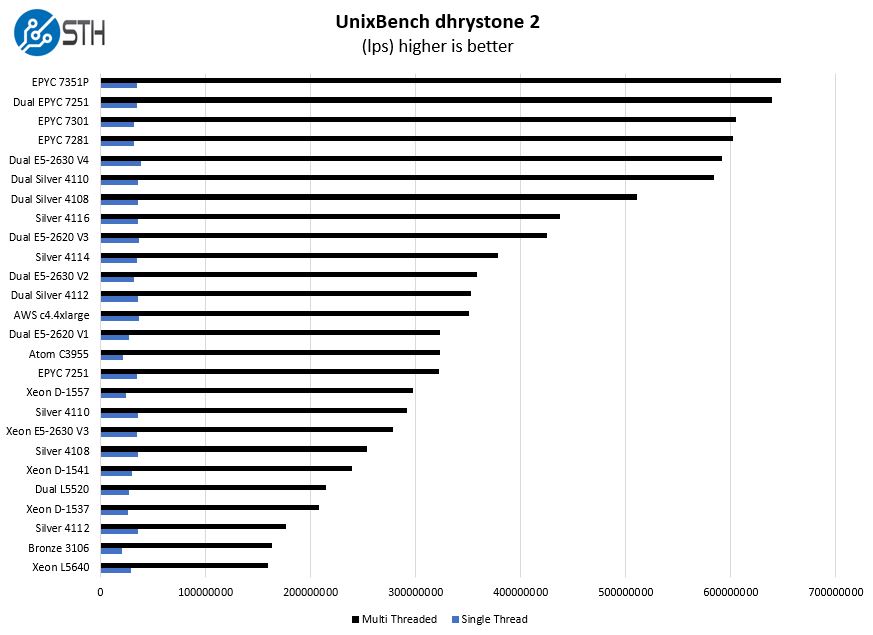
And the whetstone results:
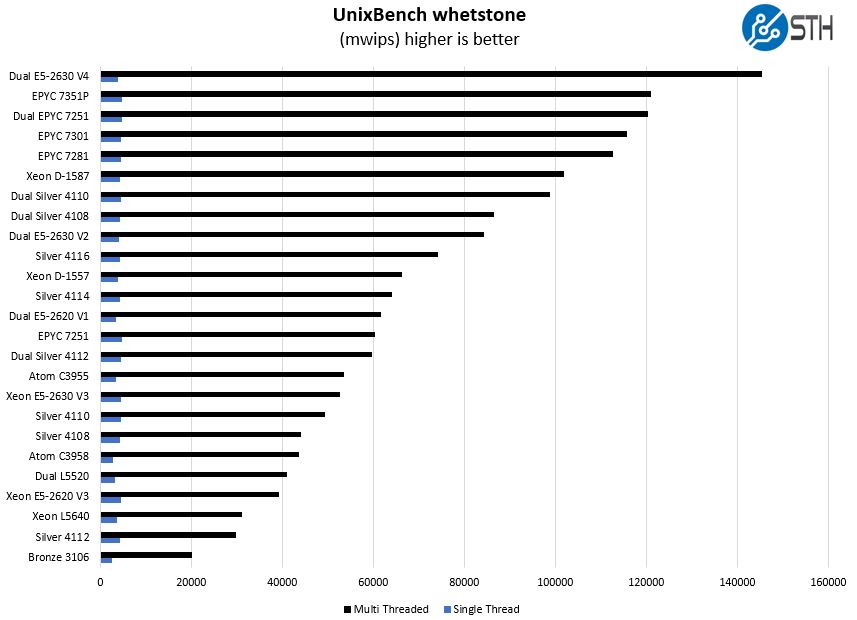
This is a trend we have seen for several AMD EPYC reviews thus far. Excellent performance across the board.
GROMACS STH Small AVX2/ AVX-512 Enabled
We have a small GROMACS molecule simulation we previewed in the first AMD EPYC 7601 Linux benchmarks piece. In Linux-Bench2 we are using a “small” test for single and dual socket capable machines. Our medium test is more appropriate for higher-end dual and quad socket machines. Our GROMACS test will use the AVX-512 and AVX2 extensions if available.
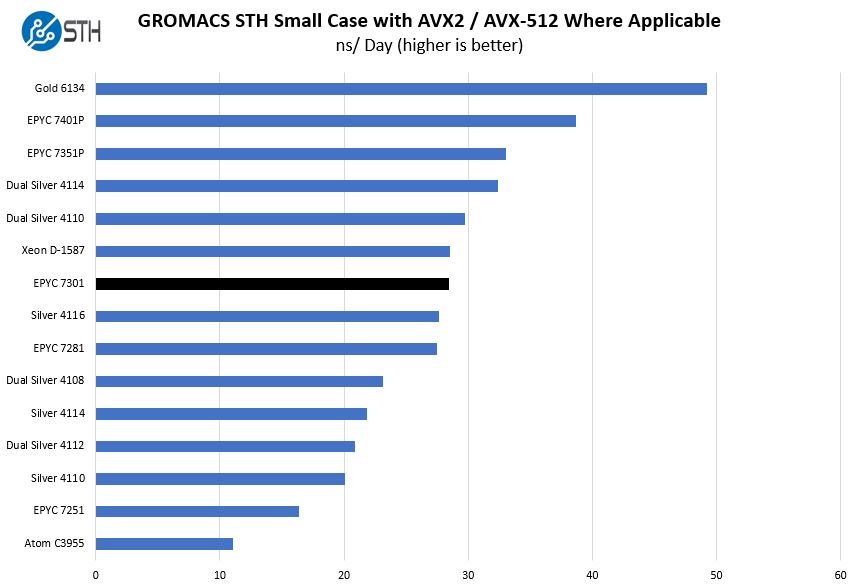
Here we have both the AMD EPYC 7351P and AMD EPYC 7401P parts, the most price competitive “P” parts from AMD. If you are doing AVX2 workloads, we suggest getting one of those two parts. Furthermore, we can see just how much Intel neutered the Intel Xeon Silver AVX-512 implementation. Even taking advantage of that and with higher clock speeds, the Intel Xeon Silver 4116 at a 20% price premium cannot compete with the EPYC 7301. We left the 8 core Intel Xeon Gold 6134 in this chart just to show how much better the dual FMA AVX-512 implementation is on the Intel Xeon Gold 6100 and Platinum 8100 range.
Chess Benchmarking
Chess is an interesting use case since it has almost unlimited complexity. Over the years, we have received a number of requests to bring back chess benchmarking. We have been profiling systems and are ready to start sharing results:
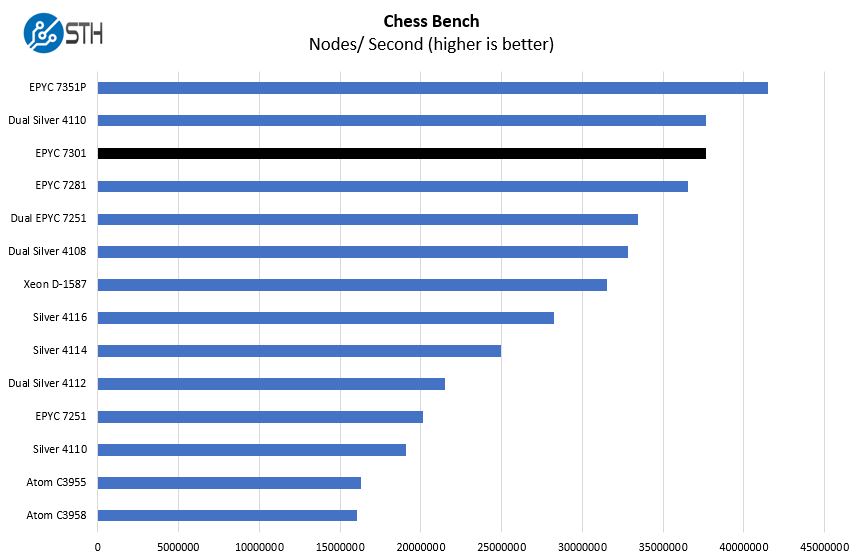
Again we see strong performance, above some of the entry Xeon Silver dual socket configurations. We also see a nice performance bump for using the single-socket only EPYC 7351P part. If you are getting the EPYC 7301, the major benefit is the ability to run in two processor mode.
A Note on Power Consumption
The other side of the equation is power consumption. The AMD EPYC 7301 is putting up some impressive benchmark numbers, but that does have an associated cost. Here is what we saw on our PDU after a few runs:
- Idle: 76W
- 70% Load: 207W
- 100% Load: 241W
- Peak: 314W
Note these results were taken using a 208V Schneider Electric / APC PDU at 17.7C and 71% RH. Our testing window shown here had a +/- 0.3C and +/- 2% RH variance. The figures are certainly more than the Intel Xeon Silver line, but with that extra power consumption, AMD is delivering a more expandable platform and more performance.
Market Positioning
As we pointed out in our dual AMD EPYC 7251 review, AMD has a number of competitive vectors. The obvious competition is the Intel Xeon single socket line. AMD also has P series parts that compete in this market.
AMD EPYC 7301 v. Intel Xeon Silver
In general, the $825 AMD EPYC 7301 will outperform the Intel Xeon Silver line in the vast majority of workloads. It has more cores (16), more threads (32), more cache (64MB L3), more RAM capacity (8 DDR4 channels, 16 slots and 2TB capacity), and more PCIe for I/O.
The Intel Xeon Silver at this point is solely an option for low power servers, low spec servers, or those where you need an Intel chip. Price performance, AMD offers a lot, but there is more competition on the AMD EPYC side.
AMD EPYC 7301 v. AMD EPYC
On the AMD EPYC 7301 there is a clear performance advantage over the AMD EPYC 7281 and competitive with dual AMD EPYC 7251’s. At the same time, in a single socket configuration, we like using the P series parts in this price range, either the higher clocked AMD EPYC 7351P or the slightly more expensive AMD EPYC 7401P with 50% more cores (24) at a scant $250 premium.
If you want to look at what AMD is doing in terms of single socket pricing, across its line and with respect to Intel, check out AMD EPYC’s Extraordinarily Aggressive Single Socket Mainstream Pricing.
Final Words
Overall we are seeing a great high-performance option in the sub $1000 market. As you likely gleaned from this review, we like the AMD EPYC 7301 in dual socket configurations. We have benchmarks run as you may have gleaned from the c-ray 1.1 8K results shown above. That dual socket review is forthcoming. If you are buying a dual socket capable AMD EPYC server, with only one CPU installed eyeing future upgrades, this is perhaps our choice for a 16 core part. If you are buying a single socket server, the AMD EPYC 7351P / 7401P are amazing values.
We know many of our readers have specific workloads they use to evaluate performance for server purchases. Through our DemoEval program, we can help you run your workload on these machines and get real-world data to help guide your purchasing decisions. The STH / DemoEval lab now has chips and systems to cover ~50% of all AMD EPYC 7000 series and Intel Xeon Scalable CPUs. If, for example, you are a software company and want to evaluate a few processor options for an appliance, feel free to reach out and we can help with that. Our goal is to provide a subset of public data but our test runs are now generating well over 1000 different performance data points on each 1P and 2P configuration for our clients.

